Oak Tree Leaves: Identification Guide (With Pictures)
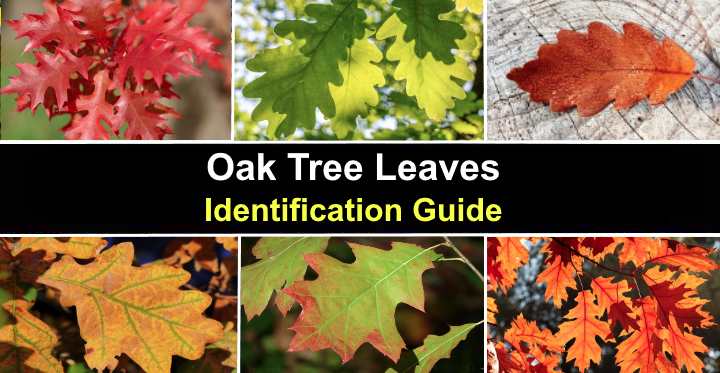
Oak tree leaves are characterized by their deep, rounded, or pointed lobes. By examining the shape, size, and lobe tips, you can easily differentiate between the red oak family and the white oak family. Furthermore, the identification of oak leaves can assist in determining the specific species of the oak tree.
In this extensive oak tree leaf identification guide, you will learn about the common characteristics of common oak tree leaves and other features of these hardwood trees.
Identifying the species of oak tree leaves can be a straightforward process once you understand what to observe. However, there are alternative methods to determine the type of oak tree. Characteristics such as oak tree acorns, bark, and overall shape can aid in recognition. Nonetheless, oak tree leaves remain the most readily identifiable feature of these magnificent deciduous trees.
How to Identify Oak Leaves
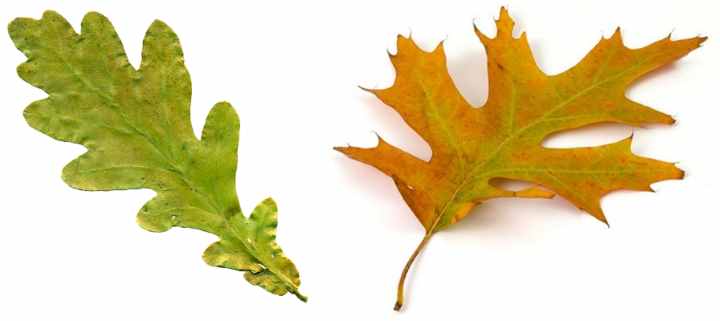
White oak leaves vs. red oak leaves: white oak leaves usually have rounded tip (left) whereas the leaves of red oak trees generally have pointed tips (right)
To accurately identify oak tree leaves, it is important to examine the shape of the lobes along the leaf margins. The lobe characteristics, whether rounded or pointed with bristled tips, vary depending on the oak tree type—red or white. Typically, oak tree leaves exhibit an oblong to obovate shape.
How to Identify Red Oak Leaves
Leaves from red oak trees are easily identified because of their irregular, pointed lobes with bristle-tipped teeth. You will also notice prominent leaf veins on red oak foliage that stretch to the tips. Also, the indentations between the lobes are typically sharp.
Most red oak leaves measure 4” to 8” (10 – 20 cm) long with seven to nine (sometimes 11) pointed lobes of varying depths.
The exception to the red oak leaf shape is with some evergreen oak trees. For example, the willow oak tree has thick, leathery, linear-shaped leaves with smooth edges and no lobes. Additionally, the large lanceolate leaves have a wavy margin for the entire length.
How to Identify White Oak Leaves
Leaves from types of white oak trees are the characteristic oak leaves most people associate with the tree species. White oak leaves have lobes that are rounded and can be deep or shallow, depending on the species of the oak tree. You should also count the number of lobes to identify the tree using the oak leaf.
Typically, white oak leaves measure between 5” and 9” (13 – 23 cm) long. Like red oaks, leaves from white oak trees have up to nine lobes around the margin.
Types of Red Oak Tree Leaves (with Pictures) – Visual Identification Guide
Let’s look in detail at the identifying features of oak leaves from the group of red oaks.
Black Oak Tree Leaves (Quercus nigra)
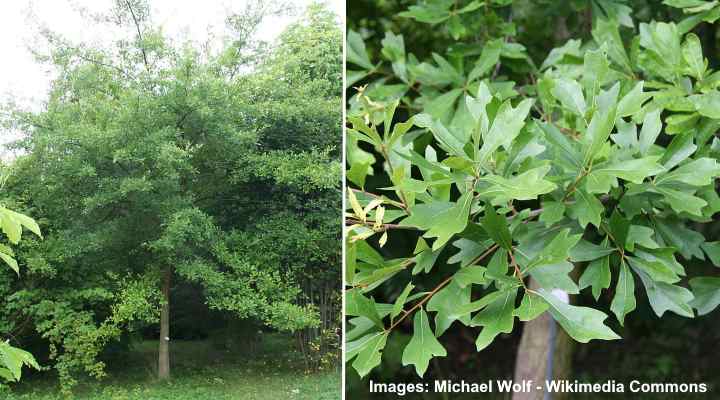
Black oak tree and leaves
Oak leaves from the black oak species are bluish-green and spatula-shaped with pointed lobes and deep, rounded incisions. The three bristle-tipped lobes on the apex are an identifying feature of black oak leaves. Additionally, the leaves have a distinctive strong veining pattern. The leaves measure 2” to 4” (5 – 10 cm) long.
Also called the water oak, the American black oak is a fast-growing deciduous tree. The medium-sized tree grows 50 to 80 ft. (15 – 24 m) tall. Apart from the pointed leaves, other identifying features are its black oak acorns measuring 0.5” to 1” (1.3 – 2.5 cm) long and dark brown to burgundy scaly bark.
Water Oak Leaves (Quercus falcata)
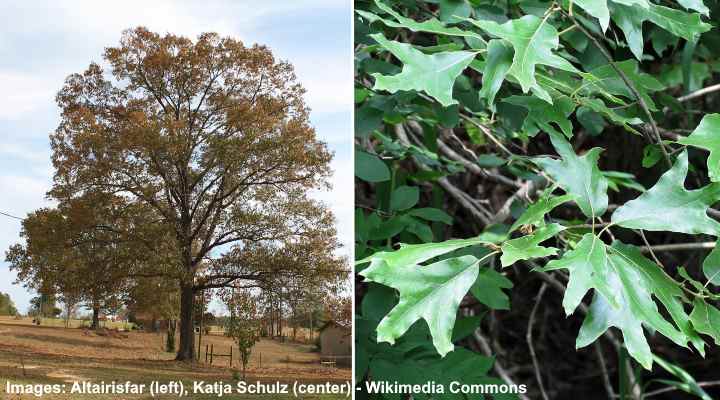
Water oak tree and leaves
Also called the southern red oak, the water oak leaves are easily identifiable due to their tan undersides and dark, lush green upper sides. The deciduous leaves have three to five bristle-tipped irregularly shaped lobes and a U-shaped base. The large leaves turn reddish brown in the fall.
Water oak leaves measure 3” to 6” (7.5” – 15 cm) long. Other identifiable features of the tree are its copper-colored oval acorns with bowl-shaped scaly caps and dark brown bark with vertical ridges. Water oak trees grow 60 to 100 ft. (18 – 30 m) tall.
Cherrybark Oak Leaves (Quercus pagoda)
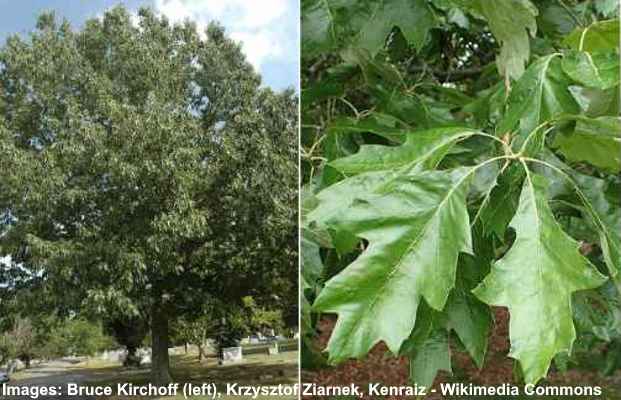
Cherrybark oak tree and leaves
Oak leaves from the cherrybark oaks are glossy dark green, ovate leaves with five to 11 bristle-tipped lobes at right angles to the midrib. Compared to other oak leaves, these pointed leaves are large, measuring 5” to 8” (13 – 20 cm) long and 5” (13 cm) across.
The distinctive oak leaves have a shape of a Chinese pagoda—hence its botanical name. The leathery oak leaves are luscious green in spring and summer, turning golden yellow or coppery-brown in the fall. The oak trees are native to North America and grow up to 130 ft. (40 m) tall.
American Red Oak Leaves (Quercus rubra)

American red oak tree in the autumn. In the right picture American red oak leaves
The leaves on the American red oak have characteristic pointed lobes with sharply pointed tips. The dark, lustrous green leaves have seven to 11 lobes and relatively small sinuses (incisions between the lobes). Typically, the bristly lobes in the leaf’s center are the largest.
American red oak leaves grow 5” to 8” (13 – 20 cm) long. The U-shaped incisions reach halfway to the midrib, and the pointed leaves have an overall uniform shape.
Also called the eastern red oak, this red oak tree’s other identifying features are the following:
- Egg-shaped brown distinctive acorns sitting in flat, saucer-shaped cups
- Reddish-brown bark with scaly ridges
- Russet-red to bright red fall color
Scarlet Oak Leaves (Quercus coccinea)
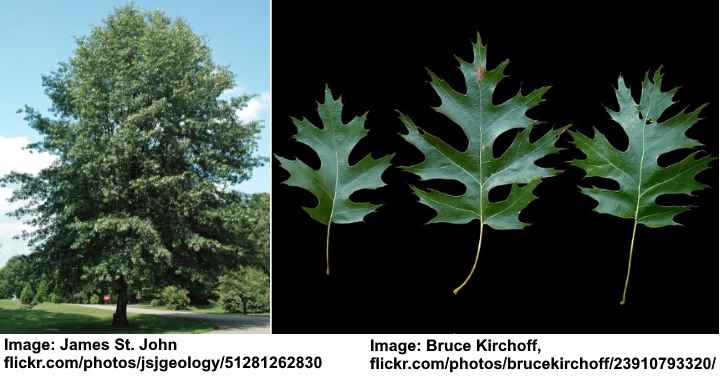
Scarlet oak tree and leaves
Scarlet oak tree leaves have a distinctive shape with seven lobes and deep C-shaped incisions between each lobe. Each pointed lobe has three to seven bristles on the tip. The oak leaves measure 3” to 6” (7.5 – 15 cm) long. The oak tree’s outstanding feature is its bright scarlet-red fall colors.
The scarlet oak tree is a medium-sized deciduous tree growing 50 to 70 ft. (15 – 21 m) tall. The oak tree’s fruit is an ovate-shaped acorn in a deep green to pale brown scaly cup. In the fall, the lush oak tree foliage turns an attractive bronze color.
The scarlet oak tree leaf shape resembles the red oak (Quercus rubra) and the eastern black oak (Quercus velutina).
Eastern Black Oak (Quercus velutina)
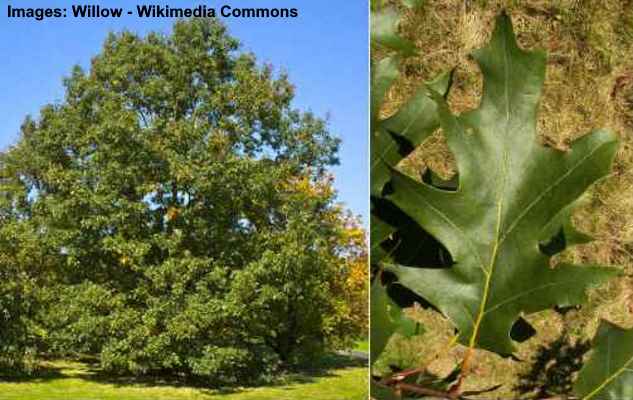
Eastern black aak tree and leaves
Leaves on the eastern black oak tree have a distinct spiky appearance due to the five to seven bristles at the tip of each large lobe. In addition, the shiny green oak leaves have seven to nine pointed lobes with deep U-shaped incisions between them. The black oak leaves measure up to 10” (25 cm) long.
Other identifying features of the eastern black oak are elliptic brown acorns measuring 0.75” (2 cm) long. In the fall, this red oak species turns spectacular orange, brown, or yellow shades.
Southern Live Oak Leaves (Quercus virginiana)
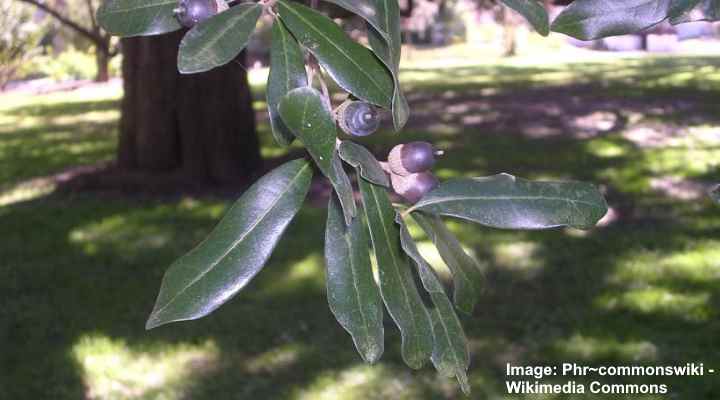
Southern live oak tree leaves and acorns
One of the most spectacular evergreen oak trees is the southern live oak. The tree’s leathery green leaves have downy undersides and lack the distinctive lobes of typical oak trees. The oblong leaves with their rounded apexes measure 2” to 5” (5 – 13 cm) long and have smooth margins.
The southern live oak is native to Texas, Florida, and other southern states. The oak tree has lower limbs stretching horizontally and a rounded crown. The curved branches are often covered in Spanish moss that dangles from the twisting branches. The magnificent oaks measure 40 to 80 ft. (12 – 24 m) tall and up to 100 ft. (30 m) wide.
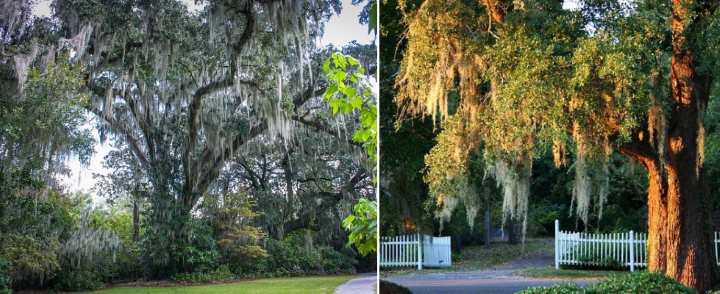
Southern live oak trees covered in Spanish moss
Laurel Oak Leaves (Quercus laurifolia)
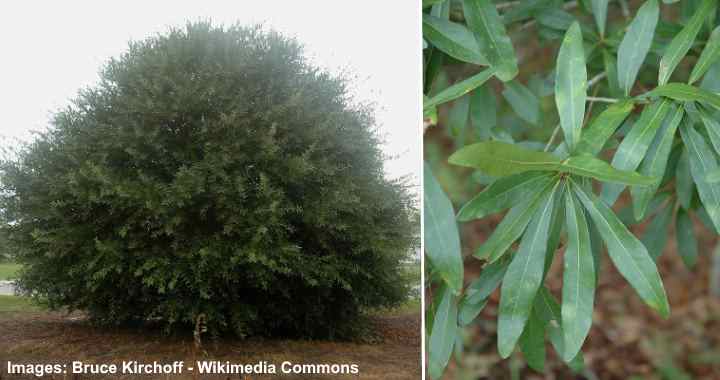
Laurel oak tree and leaves
Leaves from the laurel oak tree are elliptical, oblong leathery leaves with pointed tips. As the common and botanical names suggest, the oak tree’s foliage resembles laurel leaves, not characteristic lobed oak leaves. The green leaves are glossy on the upper side and smooth underneath. They measure 2” to 4” (5 to 10 cm) long.
Laurel oak trees are native to the southeastern United States and can withstand growing in swampy ground. The tree’s dark brown acorns have ridges running from the apex to the scaly cap that covers one-third of the nut.
Laurel oaks grow 40 to 60 ft. (12 – 18 m) tall and wide. They thrive in well-drained, moist soils in full sun or partial shade.
Willow Oak Leaves (Quercus phellos)
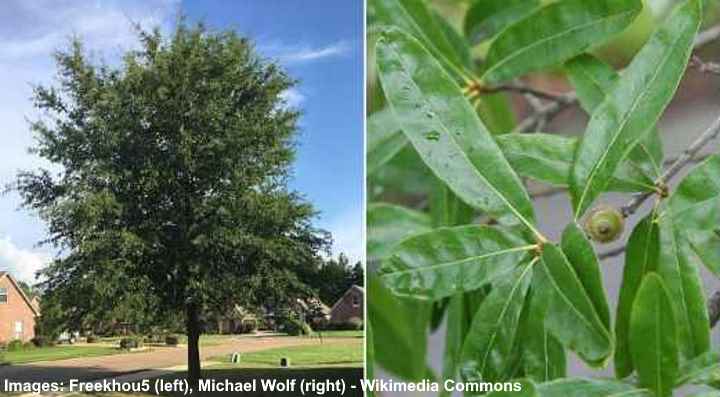
Willow oak tree and leaves
Willow-like leaves of the species Quercus phellos are easy to identify due to their long, linear shape and bright green color. The lanceolate leaves have a bristle-tipped apex, measuring 4” to 5” (10 – 13 cm) long. The pointed leaves grow in an oval to rounded crown with upward spreading branches.
The willow oak tree is a fast-growing shade tree that thrives in full sun. Growing 40 to 60 ft. (12 –18 m) tall, this oak is also tolerant of drought and heat. Other identifying features are its round brown acorns sitting in thin warty caps. Like all red oaks, the acorn matures over two years.
Coast Live Oak Leaves (Quercus agrifolia)
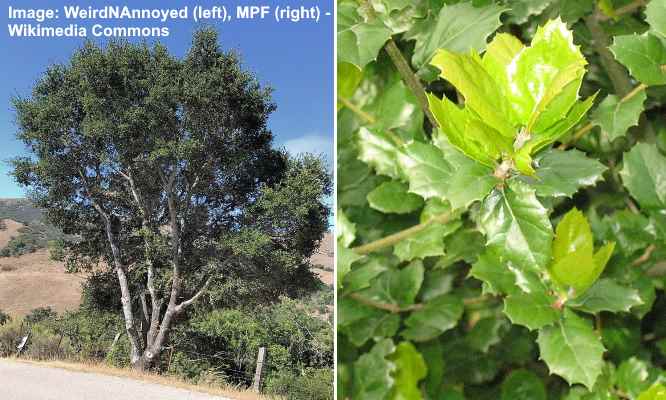
Coast live oak tree and leaves
The evergreen leaves on the coast live oak are thick, glossy, leathery, and dark green. The unusual oak leaves look like oval holly leaves with spiny teeth along the margins. The oak leaves grow on crooked, spreading branches forming an irregular crown on a short, stout trunk.
Other identifying features of the coast live oak are its brown egg-shaped acorns, clusters of dangling flowers, and dark gray bark that develops deep fissures as it matures. The coast live oak is an evergreen species of oak tree that grows 20 to 50 ft. (6 – 15 m) tall and wide.
Nuttall’s Oak Leaves (Quercus texana)
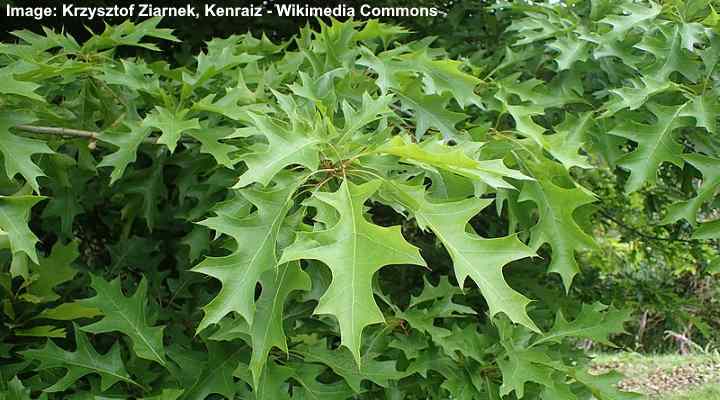
Nuttall’s oak leaves
Native to Texas, the foliage of Nuttall’s oak trees consists of lanceolate leaves with five to nine pointed lobes separated by U-shaped deep sinuses. These eye-catching unusual oak leaves have bristle tips on some lobes and stay deep green most of the year. However, in the fall, the foliage turns spectacular red and orange shades.
Each lobed leaf on the Nuttall oak measures 4” to 8” (10 – 20 cm) long. In addition to its distinctive leaves, identifying features of this red oak species are its brown oval acorns in brown scaly caps and dark brown to black bark that develops flat ridges as it matures.
Texas Oak /Texas Red Oak (Quercus buckleyi)
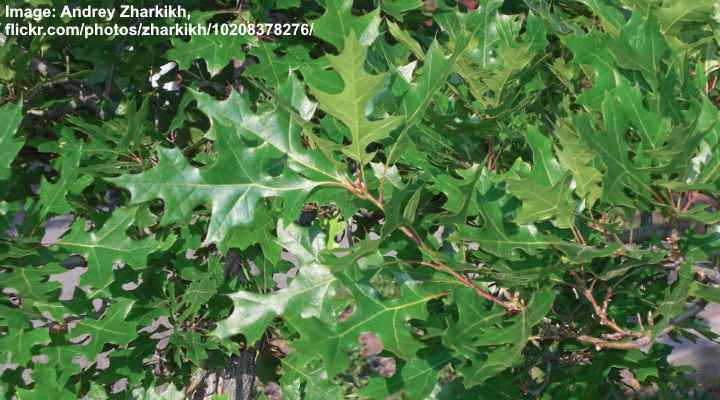
Texas red oak leaves
Texas oak leaves have five to nine deep lobes with bristle-tipped teeth. The deep U-shaped sinuses almost reach the central vein, giving the leaf a distinctive spiky appearance. The two central lobes are typically the largest ones. The obovate leaves measure 2.3” to 4.8” (6 – 12 cm) long.
Other features of the Texas red oak include small egg-shaped acorns, dark gray bark, and prominent furrows on the lower trunk. This native Texas oak tree species is small to medium, growing 50 ft. (15 m) tall. In the fall, the tree’s foliage turns an eye-catching red color.
Shumard Oak Leaves (Quercus shumardii)
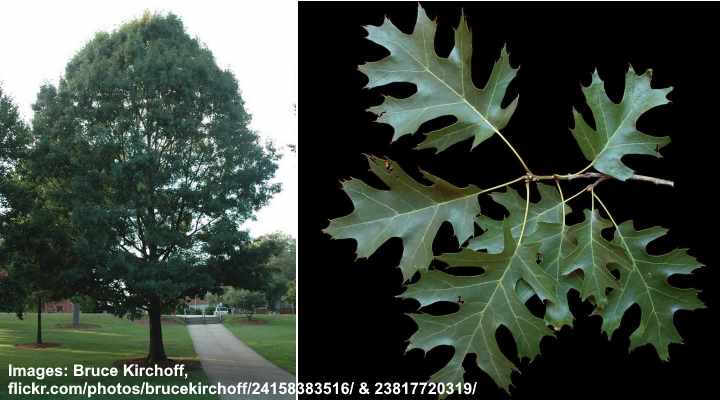
Shumard oak tree and leaves
The broad leaves of the Shumard oak have seven to nine lobes, bristle tips, and deep, C-shaped incisions between the pointed lobes. Additional identifying characteristics of the oak leaves are their dark green color with pale green undersides and attractive red or burgundy fall colors.
Shumard oak leaves, with their deep lobes and bristle tips, are easy to identify in a landscape or oak woodlands. The leaves grow up to 7” (18 cm) long and grow upright, spreading branches forming a rounded crown. The medium-sized deciduous trees grow 40 to 60 ft. (12 – 18 m) tall.
Turkey Oak Leaves (Quercus laevis)
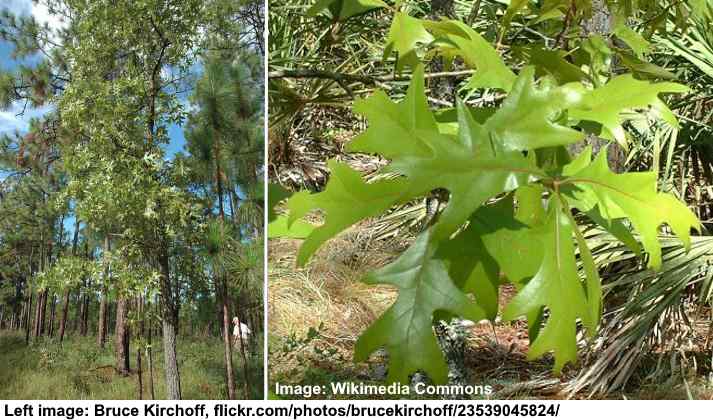
Turkey oak tree and leaves
Leaves on the turkey oak tree are easily identifiable by their unique, narrow shape and three pointed lobes like a turkey’s foot. These oak leaves have a deltoid shape with several thin lobes, a shiny green upper side, and pale green below. The oak leaves measure 4” to 8” (10 – 20 cm) and grow alternately on dark gray branches.
The unusual bristle-tipped leaf lobes make this oak tree species easy to identify. Other features of the turkey oak are its green acorns that mature to copper brown and dark gray to black bark with furrowed ridges that split to reveal a reddish inner bark.
The narrow, pointed leaves are bright green in summer, turning stunning red and rusty red colors in the fall.
Pin Oak Leaves (Quercus palustris)
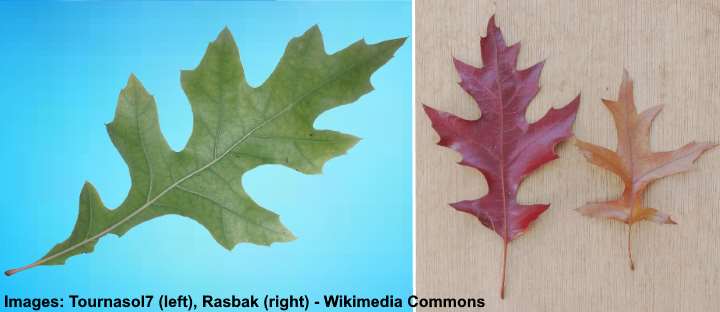
Pin oak tree leaves
Leaves on the pin oak are dark green with five or seven pointed lobes separated by deep U-shaped incisions. The elliptic oak leaves have the widest part in the middle, with a uniform dark green color on the upper and underside. Pin oak leaves measure 5” (13 cm) long and turn from deep green to orange, russet, burgundy, and copper in the fall.
The pin oak tree’s other characteristics are its round brown acorn in a smooth, shallow cup, dark brown to gray bark, and dangling clusters (catkins) of yellowish-green flowers in spring. Pin oaks grow 50 to 70 ft. (15 – 21 m) tall and up to 60 ft. (18 m) wide.
Blackjack Oak Leaves (Quercus marilandica)
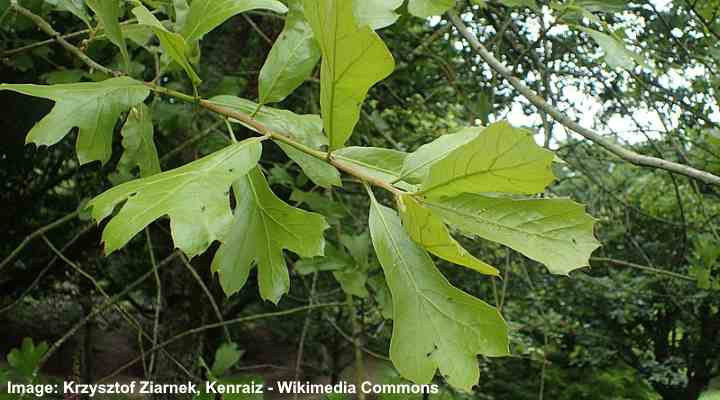
Blackjack oak leaves
The distinctive leaves on the blackjack oak tree have a wedge shape, with the widest part at the apex. Identification features of this small deciduous oak tree are its leathery leaves with three lobes and shallow sinuses, a dark green upper side, and a fuzzy underside. The blackjack-like leaves measure up to 7” (18 cm) long.
This native oak tree ranges from Florida and Texas to Missouri and New Jersey. The small deciduous tree measures 20 to 40 ft. (6 – 12 m) tall and wide. This oak is also identified by its oblong acorns, blackish bark, and eye-catching yellowish-brown and russet fall colors.
Japanese Evergreen Oak Leaves (Quercus acuta)
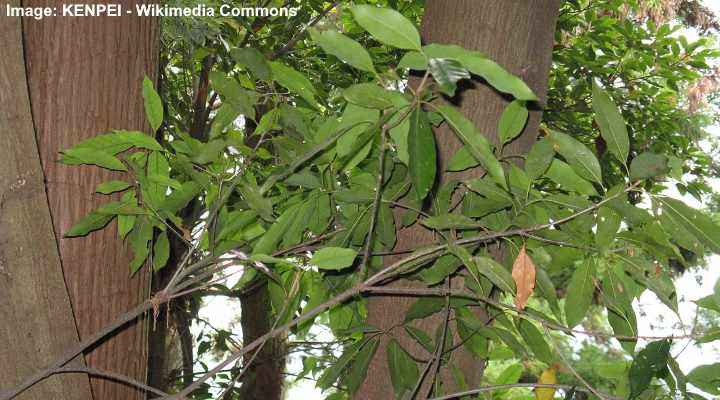
Japanese evergreen oak leaves
The Japanese evergreen oak tree is one of the smallest oak trees with lanceolate leaves. The dark green glossy oak leaves measure 2.5” to 5” (6 – 13 cm) long. New leaves emerge purplish-brown before turning green. Additionally, the pointed leaves have wavy, serrated margins.
The Japanese evergreen oak tree only grows in the southernmost areas of the United States. The small tree grows 20 to 30 ft. (6 – 9 m) tall and up to 20 ft. (6 m) wide. The ornamental landscape tree has an oval crown with dense foliage.
Graves Oak Leaves (Quercus gravesii)
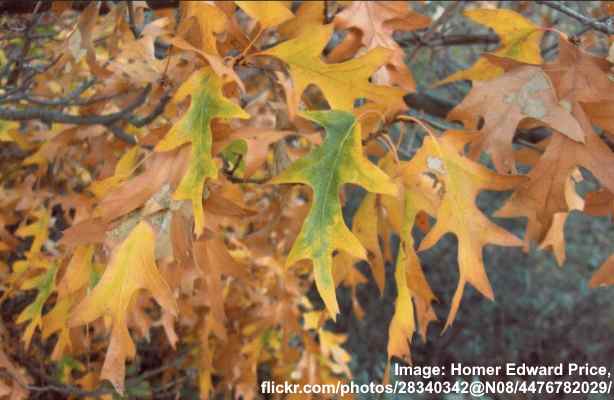
Graves oak leaves
Graves oak tree is a deciduous tree species in the red oak group. Its glabrous, green, holly-like leaves have triangular lobes with spiny bristle tips. The shiny lanceolate leaves grow to 5.5” (14 cm) long. In the fall, the tree’s foliage turns a stunning scarlet-red color.
Graves oak tree grows up to 43 ft. (13 m) tall. Identifying features of the oak tree are its black bark with flat ridges, narrow fissures, and egg-shaped grown acorns.
Types of White Oak Leaves (with Pictures) – Visual Identification Guide
White oak trees are characterized by their distinctive lobed leaves that are wider at the apex than the leaf base. The sinuses can be either U-shaped or C-shaped; some are deep, reaching almost to the midrib. White oaks are also recognized for their fast-maturing acorns that mature in a single season.
Please continue reading this detailed oak tree leaf identification guide for species of white oak trees.
English Oak Leaves (Quercus robur)
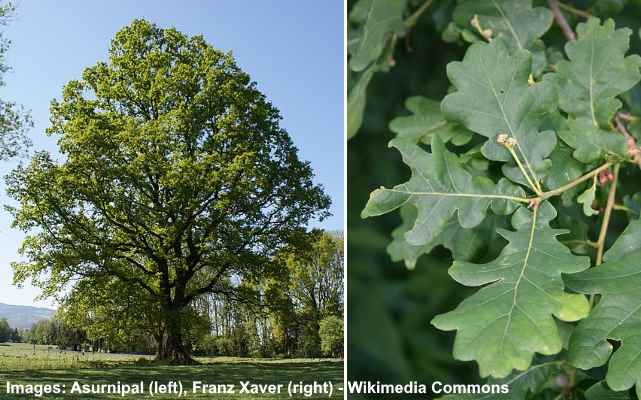
English oak tree and leaves
The leaves on the English oak tree have three to seven rounded lobes. The identifying feature of the tree’s leaves is the ear-like lobes at the leaf’s base. English oak leaves grow 3” to 5” (7.5 – 13 cm) long and have a dark green upper side and bluish-green underside.
The English oak tree is a large, deciduous tree with a majestic, broadly spreading crown. The English oak’s other characteristic features are its furrowed, dark gray bark with vertical ridges, elongated, oval acorns in a green, scaly cap, and glorious golden-yellow fall color.
Post Oak Leaves (Quercus stellata)
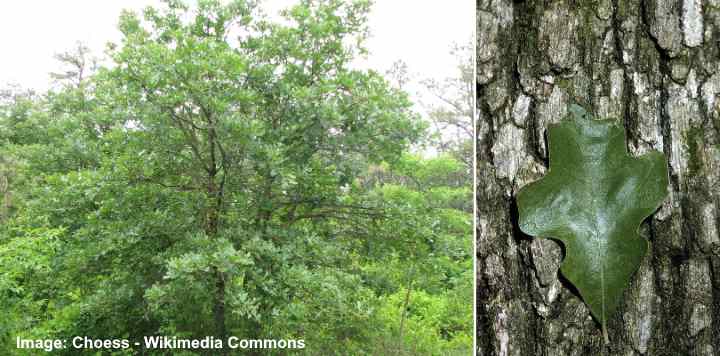
Post oak tree, bark and leaf
The post oak tree leaves are easily identifiable due to their unique shape with three prominent lobes at the apex. The post oak leaves measure 4” to 8” (10 – 20 cm) long, with four lobes on each side. The distinctive feature of this oak tree is its shape like a Maltese cross.
The post oak tree has recognizable, deeply lobed margins. The deciduous tree thrives in well-drained poor soils and full sun and withstands drought. The medium-sized tree grows 40 to 50 ft. (12 – 15 m) tall. Additionally, it has egg-shaped acorns 1” (2.5 cm) tall and a beautiful golden brown fall color.
The post oak tree is a native tree to Florida and other southeastern states.
Bur Oak Leaves (Quercus macrocarpa)
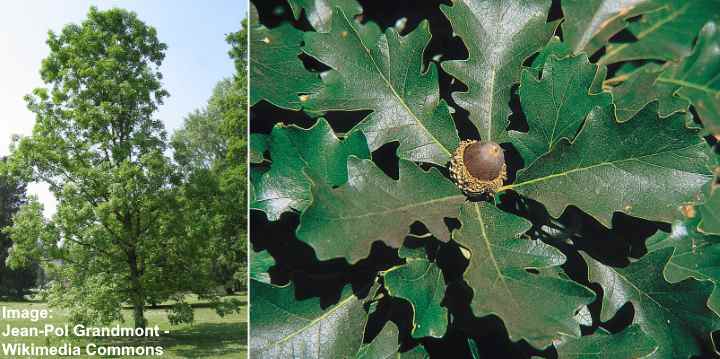
Bur oak tree, leaves and acorn
Bur oaks have large leaves—some of the largest of all oak species—with two deep sinuses in the middle. The oak leaf margins have five to seven lobes and a wedge shape. These round-lobed leaves measure 6” to 12” (15 – 30 cm) long.
A distinguishing feature of the bur oak tree is its large round acorns sitting in deeply fringed caps. The brown-copper oak tree fruit measures 1.5” (3.8 cm) wide, and the hairy cup covers around one-half of the acorn. Growing 60 to 80 ft. (18 – 24 m) tall with a wide, open crown, this hardy tree is ideal as a shade or lawn specimen.
Sand Post Oak Leaves (Quercus margarettae)
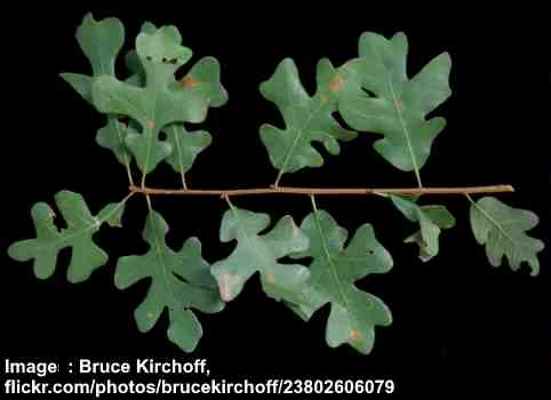
Sand post oak leaves
Also called the dwarf post oak, the leathery leaves on this deciduous species have three to five irregular lobes and a wide, rounded apex. Each oak leaf measures 2” to 4” (5 – 10 cm) long and 1” to 2” (2.5 – 5 cm) at the widest part.
Sand post oak trees are native to Florida and Texas and thrive in USDA zones 7 through 9. As its name suggests, the oak tree performs best in sandy soil. The small, shrub-like oak grows 30 to 40 ft. (10 – 12 m) tall and wide. Its light brown acorns are oval and sit in a bowl-shaped cap and measure 0.5” (1.3 cm) tall.
Oregon White Oak Leaves (Quercus garryana)
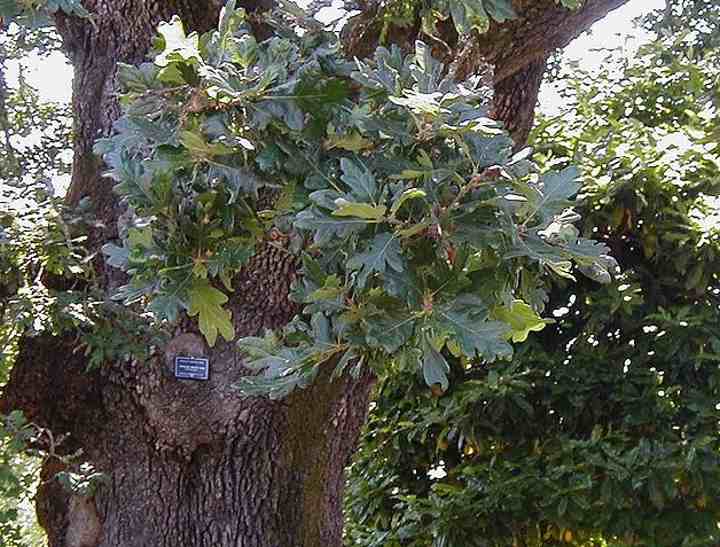
Oregon white oak bark and leaves
The leaves on the Oregon white oak tree have an oval shape with three to seven deep lobes on each margin. The oak leaves have a glossy green upper side and a slightly fuzzy underside. The deciduous blades measure 2” to 6” (5 – 15 cm) wide and up to 3” (7.5 cm) wide.
Other identifying features of the Oregon white oak are light gray scaly bark, a rounded crown with an attractive branching pattern, and small pale brown acorns measuring 1” (2.5 cm) long.
White Oak Leaves (Quercus alba)
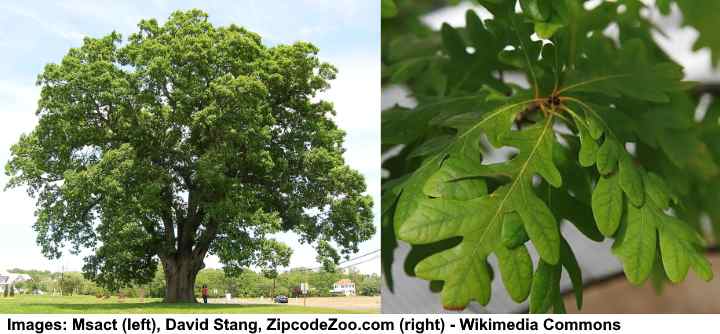
White oak tree and leaves
The distinctive leaves on the white oak tree have several finger-like lobes with rounded tips. Each leaf has seven to nine slender lobes separated by deep sinuses. Additionally, the leaves have a rounded apex and wedge-shaped base. White oak leaves measure 4” to 9” (10 – 22 cm) long.
White oak trees are beautiful landscape trees in the fall. The oval-rounded crown, with its dark green leaves, turns a spectacular russet-red, filling landscapes with warm autumn colors. In addition, the oak produces brown, oval acorns measuring 1” (2.5 cm) long, sitting in a lumpy tan cap.
Other common names for this popular oak tree include the northern white oak, forked-leaf oak, Quebec oak, and eastern white oak.
Sessile Oak Leaves (Quercus petraea)
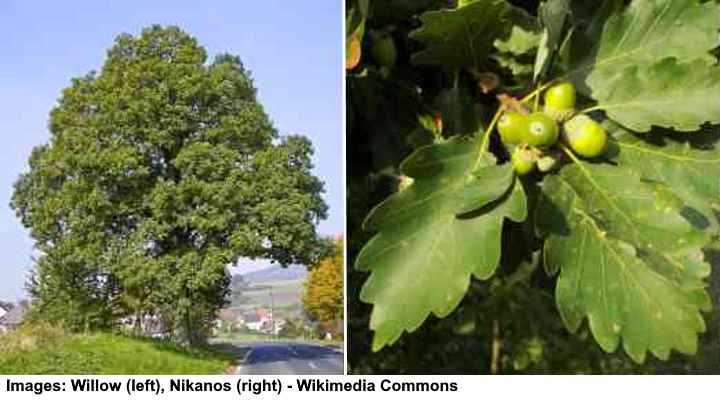
Sessile oak tree and leaves
Also known as the Irish Oak, this large deciduous tree produces obovate leaves with numerous shallow rounded lobes around the edges. The green leaves attach to branches with a 1” (2.5 cm) long petiole. The leaves measure 2.75” to 5.5” (7 – 14 cm) long and up to 3” (7.5 cm) wide.
Sessile oak trees are native to Europe. The large shade trees grow 65 to 131 ft. (20 – 40 m) tall and have a rounded, pyramidal crown. In addition to its distinctive leaves, an identifying feature of the oak tree is its stalkless (sessile) acorns growing in pairs. The brown, rounded acorns measure 0.75” to 1.25” (2 – 3 cm) long.
Chestnut Oak Leaves (Quercus montana)
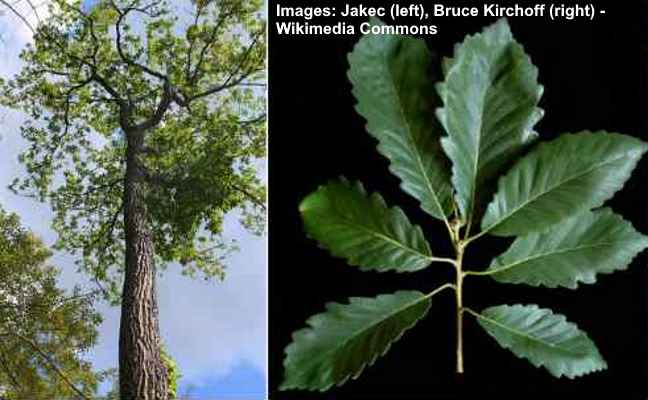
Chestnut oak tree and leaves
The leaves of the chestnut oak tree are lance-shaped with coarse teeth along the edges. The large oak leaves are 5” to 9” (13 to 23 cm) long and 4.5” (11 cm) wide. In fall, the leathery green leaves turn golden, reddish-yellow, or brown.
Chestnut oak trees are medium to large deciduous trees. This white tree species has dark, scaly bark with broad, fissured ridges and rounded oval, chestnut-brown acorns in small scaly cups. Chestnut oak trees grow 60 to 72 ft. (18 – 22) tall.
Bluff Oak Leaves (Quercus austrina)
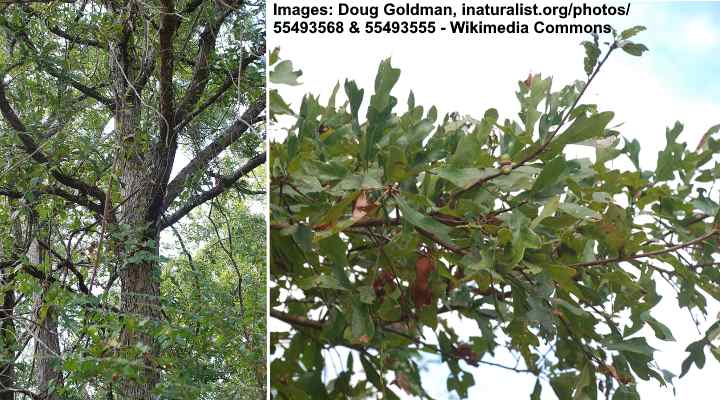
Bluff oak tree and leaves
The bluff oak tree has narrow leaves with shallow rounded lobes. This oak tree’s leaves measure 4” to 8” (10 – 20 cm) long and up to 4” (10 cm) wide. The attractive, showy green leaves turn spectacular shades of copper, yellow, and orange in the fall.
Bluff oak trees are native to the southeastern part of North America. The medium-sized shade trees grow 45 to 60 ft. (13 – 18 m) tall and feature an oval, rounded crown. The oak tree’s brown oval acorns measure 0.5” to 1” (1.3 – 2.5 cm) tall and typically grow in pairs. The oak has pale gray, scaly bark with broad ridges.
Chinquapin Oak Leaves (Quercus muehlenbergii)
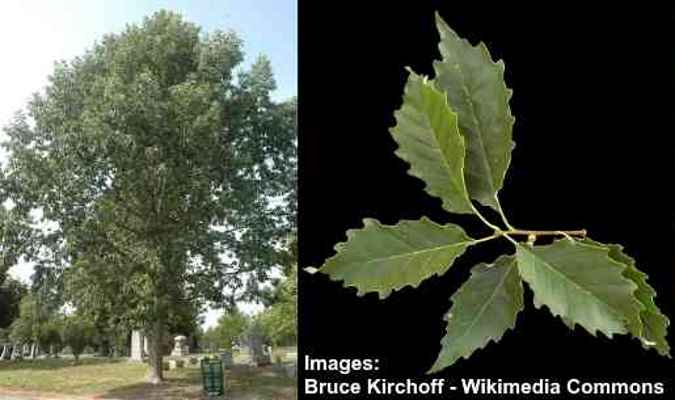
Chinquapin oak tree and leaves
The chinquapin oak tree leaves are similar to the chestnut oak tree. The oblong, lance-shaped leaves have serrated margins with shallow, pointed lobes. The glossy green leaves measure 4” to 8” (10 – 20 cm) long and have a pointed tip and rounded base. The foliage’s fall color is varying shades of yellow.
The chinquapin oak tree is native to North America, grows 40 to 60 ft. (12 – 18 m) tall, and has an open, rounded crown spreading 70 ft. (21 m) wide. Other identifying features of the oak tree are its light brown, oval acorns growing up to 1” (2.5 cm) long and thin, light gray bark with irregular fissures.
Swamp White Oak Leaves (Quercus bicolor)
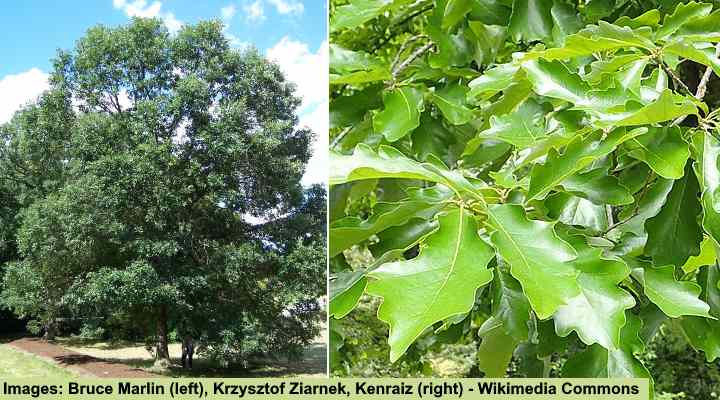
Swamp white oak tree and leaves
The swamp white oak tree leaves are two-toned, with a dark green glossy upper side and silvery-white underside. The oblong, egg-shaped leaves have slightly lobed margins with six to ten pairs of dentate teeth. The large oak leaves grow up to 7” (18 cm) long and turn shades of orange, yellow, or red in the fall.
The identifying feature of swamp oak trees is their dual-color silver and green leaves, creating a shimmering effect in the wind. Additionally, the small brown acorns sit in grayish scaly cupules, and its thick, peeling, grayish-grown bark has deep furrows.
The swamp white oak tree grows 50 to 60 ft. (15 – 18 m) tall and wide in USDA zones 4 through 8.
Chapman Oak Tree Leaves (Quercus chapmanii)
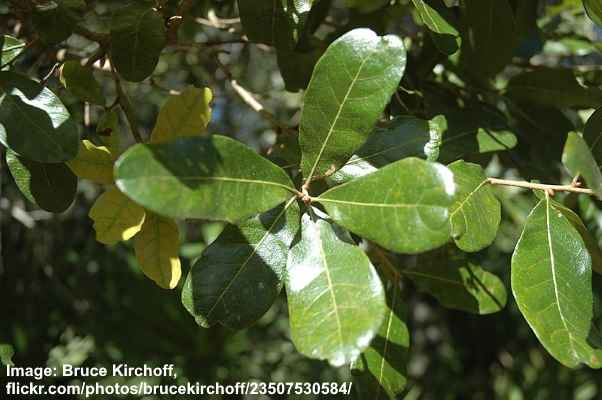
Chapman oak leaves
The Chapman oak is a drought-tolerant oak native to Florida that grows as a large shrub or small tree. The oak leaves are elongated ovate with a rounded apex and no prominent lobes around the margins. The leaves measure 1.5” to 3.5” (4 – 9 cm) long. In the fall and winter, the foliage turns red or yellow.
Because it thrives in scrub habitats, Chapman oak trees are also called scrub oaks. The heat-tolerant oaks have characteristic brown acorns sitting in a grayish cap. Chapman oaks grow 6 to 30 ft. (1.8 – 10 m) tall.
Myrtle Oak Leaves (Quercus myrtifolia)
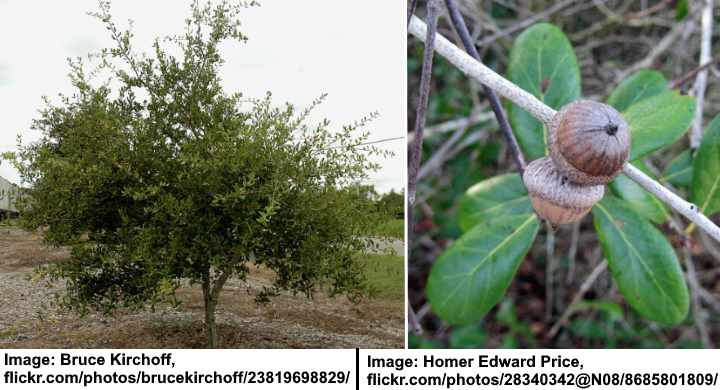
Myrtle oak tree, leaves and acorns
Evergreen oak leaves on the myrtle oak shrub are oval, green leathery leaves. The unusual oak leaves have curled margins that roll under. These glossy green leaves measure 2” (5 cm) long and 1” (2.5 cm) wide. The shrub’s evergreen foliage persists through winter, and new leaves appear in spring.
Myrtle oak is an erect evergreen shrub-like bushy tree that grows 15 to 20 ft. (4.5 – 6 m) tall. The oak shrub is ideal for growing in xeric landscapes and is tolerant of drought, sandy soils, and salty air.
Blue Oak Leaves (Quercus douglasii)
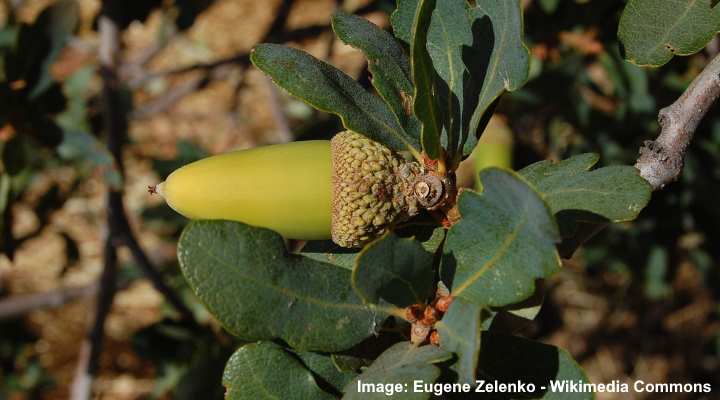
Blue oak immature acorn and leaves
The bluish-green leaves on the blue oak tree have shallow lobes and measure 4” (10 cm) long. Blue oak leaves are tough, leathery blades with a rounded apex and irregular lobes, and shallow incisions. In the fall, the dull leaves turn shades of orange, light pink, or yellow.
The deciduous blue oak tree grows 20 to 60 ft. (6 – 18 m) tall. It is identified by its short trunk, rounded top, and wide, spreading, irregular canopy. Its egg-shaped brown acorns are 1.18” (3 cm) long and have a distinctly pointed apex.
Mexican White Oak Tree Leaves (Quercus polymorpha)
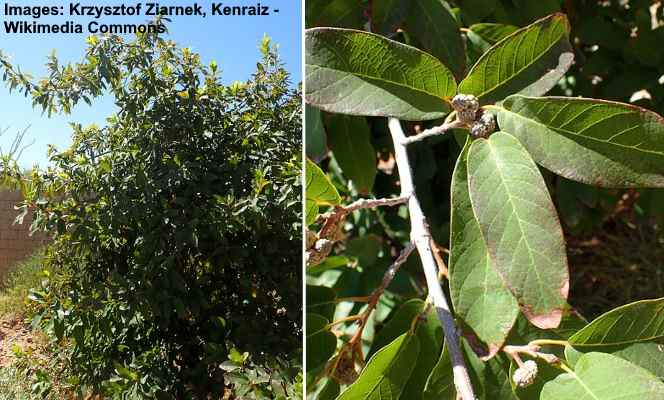
Mexican white oak tree and leaves
The Mexican white oak tree leaves are lance-shaped, leathery green blades with shallow, pointed lobes along the edges. The identifying feature of the oak leaves is the distinct raised veins. The simple leaves grow 2” to 5” (5 – 13 cm) long and are attached to branches by short petioles.
The Mexican white oak tree is a medium-sized semi-evergreen tree growing 40 ft. (12 m) tall. It has small brown, barrel-shaped acorns measuring 1” (2.5 cm) tall, sitting in a thick, warty cap covering half the nut.
Holm Oak (Quercus ilex)

Holm oak tree and leaves
Also called the holly-leaf oak tree, this spectacular evergreen tree has spiny-edged, glossy green leaves like holly leaves. The shiny leaves measure 3” (7.5 cm) long and have yellowish hairs on the underside. The leathery leaves form dense foliage growing in a large umbrella-shaped canopy.
The magnificent holm oak tree is ideal as a windscreen, evergreen privacy hedge, or shade tree in USDA zones 7 to 10. The tree grows 40 to 70 ft. (12 – 21 m) tall and has small egg-shaped acorns and gray bark with fine fissures.
Gambel Oak Tree (Quercus gambelii)
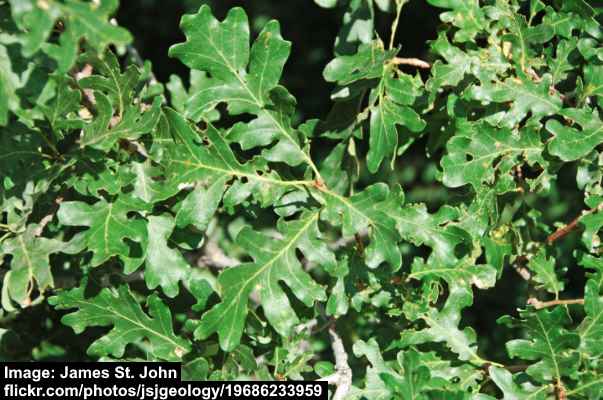
Gambel oak leaves
The leaves growing on the Gambel oak tree are identified by their rounded lobes and deep sinuses. The oak leaves have a glossy green upper surface with a pale, velvety underside. In the fall, the tree’s foliage transforms landscapes with vivid yellow and orange shades.
Depending on the location and climate, Gambel oak trees grow 10 to 30 ft. (3 – 9 m) tall. The bushy trees can grow as large, multi-stemmed shrubs or small trees. The oak tree’s acorns are 0.75” (2 cm) long, golden brown, and in a cap enclosing half of the nut.
Overcup Oak Tree (Quercus lyrata)
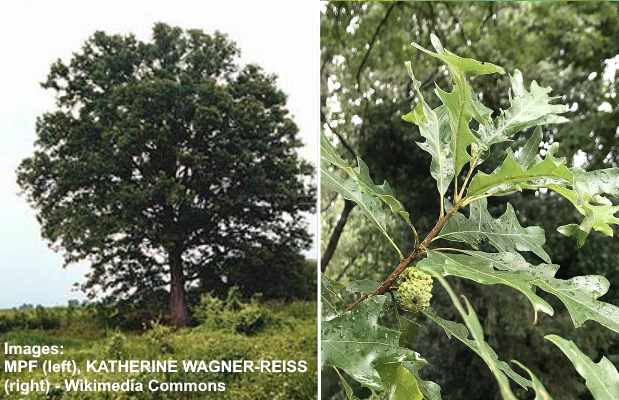
Overcup oak tree and leaves
Identifying features of the overcup oak tree leaves are their broad, lyrate shape and five to nine deep, rounded lobes. Each oak broadleaf measures 6” to 8” long with a shiny dark green upper side and fuzzy gray-green underside. In fall, the leathery leaves turn burgundy-red or yellow.
One of the easily recognizable characteristics of the overcup oak tree is its rounded acorns, almost completely covered by the cupule. These mid-sized trees from the white oak group grow 35 to 60 ft. (10 – 18 m) tall and wide.
Related articles:
